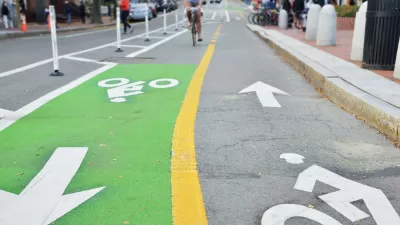Most trends are fleeting, some of them mercifully so. Some last no longer than a Lady Gaga wardrobe change. But urbanism is still, by and large, a leisurely exercise, so it's no wonder that planners still embrace fashions on a nearly generational basis. It often takes that long just to see if something works. Or not. So, while Gaga would inspire us to attach telephones to our heads and light our bustiers on fire, planners who ascribe to the principles of smart growth are still rhetorically swaddling cities in the urban equivalent of flannel. For better or worse, this age may finally be coming to a close. Don't cry, Monster.
Most trends are fleeting, some of them mercifully so. Some last no longer than a Lady Gaga wardrobe change. But urbanism is still, by and large, a leisurely exercise, so it's no wonder that planners still embrace fashions on a nearly generational basis. It often takes that long just to see if something works. Or not.
So, while Gaga would inspire us to attach telephones to our heads and light our bustiers on fire, planners who ascribe to the principles of smart growth are still rhetorically swaddling cities in the urban equivalent of flannel. For better or worse, this age may finally be coming to a close. Don't cry, Monster.

Two weeks ago in USA Today, veteran real estate writer Haya El Nasser reported that the term "smart growth" may have reached the end of its life-cycle. Though cities are embracing smart growth with everything from light rail lines to downtown mixed use developments, planners it seems have simply grown tired of the term. The heir apparent, writes Nasser, is "intelligent cities."
It's unclear whether an "intelligent city" would look any different from a "smart growth" city. As Nasser notes, sometimes people just need a change. I'm not sure that this change is a healthy one, though.
Nasser highlights a few advantages of this term, whose provenance is apparently unknown. By ascribing intelligence to cities, it underscores cities' role as hubs of knowledge, as if the knowledge in a city is greater than that of the sum of its inhabitants. That much is probably true. Moreover, she notes that the use of city -- as opposed to the vaguely cancerous term "growth" -- emphasizes the unequivocal primacy of cities in our culture and economy. With apologies to Joel Kotkin, the age of the intelligent city may not leave much room for the exurb or the reinvented bedroom community.
Just the same, "intelligent cities" is remarkably limiting.
Now more than ever, I don't think anyone knows what a "city" is anymore -- and I say that admiringly. They have grown and changed remarkably, even in the past generation. If cities are producers of knowledge and capital, then we would have to define them broadly, as entire metro areas. But planners rarely deal in such large regions. On the formal, rather than economic, level, planners confront the issue of scale. Is Beverly Hills a city? Is a metropolitan planning or organization or metropolitan statistical area a city? Is Mumbai a city? What about the dozen or so definitions of the Greater Tokyo area?
It's hard to call something "intelligent" if we don't even know what the thing is.
Perhaps more problematic is the abandonment of the expansive concept of growth. "Growth" doesn't happen only in cities. It happens in suburbs, exurbs, hamlets, states, and regions. In my home beat of California, it happens everywhere, and it has been happening consistently since, oh, 1849. To replace "growth" with "cities" carries two erroneous implications: 1) that a city, if it's intelligent enough, can become a static finished product; 2) that certain places that do not happen to be cities need not worry about being "smart."
But the point of urbanism is that someplace do eventually become cities, or at least they become part of cities. The constant process of growth and reinvention is central to our notion of urbanism. Growth does not necessarily equal progress -- i.e. it's not always good -- but even when cities stop growing or even contract, we can never say that they are complete or "done." Smart growth acknowledges that urban development is an unending process.
"Intelligent cities" carries the perilous connotation that a city need only get smarter but not necessarily bigger. Just keep in mind that fully half of humanity, 3.5 billion people, already live in cities. If cities, suburbs, towns, and regions don't keep growing, we're going to have another billion very unhappy people knocking at our gates.
Naturally, "smart growth" is hardly perfect either. But I think it deserves another decade or two, because that's probably how long it will take for those principles to truly take root on the ground.
At least we can dance to Gaga while we wait.

Maui's Vacation Rental Debate Turns Ugly
Verbal attacks, misinformation campaigns and fistfights plague a high-stakes debate to convert thousands of vacation rentals into long-term housing.

Planetizen Federal Action Tracker
A weekly monitor of how Trump’s orders and actions are impacting planners and planning in America.

In Urban Planning, AI Prompting Could be the New Design Thinking
Creativity has long been key to great urban design. What if we see AI as our new creative partner?

Cal Fire Chatbot Fails to Answer Basic Questions
An AI chatbot designed to provide information about wildfires can’t answer questions about evacuation orders, among other problems.

What Happens if Trump Kills Section 8?
The Trump admin aims to slash federal rental aid by nearly half and shift distribution to states. Experts warn this could spike homelessness and destabilize communities nationwide.

Sean Duffy Targets Rainbow Crosswalks in Road Safety Efforts
Despite evidence that colorful crosswalks actually improve intersection safety — and the lack of almost any crosswalks at all on the nation’s most dangerous arterial roads — U.S. Transportation Secretary Duffy is calling on states to remove them.
Urban Design for Planners 1: Software Tools
This six-course series explores essential urban design concepts using open source software and equips planners with the tools they need to participate fully in the urban design process.
Planning for Universal Design
Learn the tools for implementing Universal Design in planning regulations.
Appalachian Highlands Housing Partners
Gallatin County Department of Planning & Community Development
Heyer Gruel & Associates PA
Mpact (founded as Rail~Volution)
City of Camden Redevelopment Agency
City of Astoria
City of Portland
City of Laramie





























